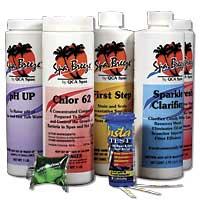Spa Chemicals
 Spa Chemicals come in a variety of brands, sizes and types. Bromine is a popular chemical sanitizer in hot tubs.
Spa Chemicals come in a variety of brands, sizes and types. Bromine is a popular chemical sanitizer in hot tubs.
Buy Hot Tub Bromine Tablets online:SpaBoss Bromine Tabs
The basic spa chemical mostly all spa owners need is either chlorine or bromine. New enzyme treatments are also available and is being used as an odor-free alterative already in some countries. Certainly the enzyme treatment can augment your current sanitizer and allow for reduced amounts. Try the hot tub enzyme treatment in Canada. Or you can read more about hot tub enzymes here.
Chlorine is available in a liquid, solid pucks or powder. Bromine is mainly used in the puck form.
Some chemical feeders float on the water while others are integrated into the filter system. The diameter of the pucks must be considered when ordering to make sure they fit inside the chemical dispenser.
In some locations the water used to fill the spa may contain various minerals and even metals that can have a severe effect on the water chemistry and that will require the correct spa chemical to balance the water and maintain proper water chemistry.
A shock treatment reactivates the sanitizer and is the other main element needed.
PH for Hot Tubs Demystified
 The ph measures how acidic or basic the water is. Ph can be measured by a water test kit or by the easy to use test strips for hot tubs.
The ph measures how acidic or basic the water is. Ph can be measured by a water test kit or by the easy to use test strips for hot tubs.
The ideal range for pH in a hot tub is 7.2-7.6.
Get bromine test strips online to test for bromine and pH.
Maintaining the proper ph range is critical to having the water last longer. If the ph is left too high or too low it can damage spa components, seals, pumps and other hot tub components. Scale can build up when the ph gets too high and other problems can occur if the water is out of balance.
It is best to check the ph level a few times a week until you get the spa water under control. Ph may fluctuate more with increased use and so may need to be monitored more often. Skin irritation and rashes can occur if the water is either too acidic or too basic.
There is one more little hitch with balancing ph, and that is to monitor the total alkalinity as well. This value is also shown on most hot tub test strips. So the trick is to balance for alkalinity first as correct alkalinity allows for better control of ph.
 By determining the pH, calcium hardness, any metals and total alkalinity of your base water supply, you will better know what additional chemicals are needed.
By determining the pH, calcium hardness, any metals and total alkalinity of your base water supply, you will better know what additional chemicals are needed.
Otherwise through a little trial and error you will get to know your particular water supply and how to best balance the water.
A few tips include not filling the spa with water that was left sitting in the garden hose. Rather, water should be turned on first and the hose allowed to clear of old water to avoid putting algae causing contaminants into the spa water.
Another tip is that bathers should shower off before entering the spa. Sometimes a sun shower or outdoor showere can be handy for this purpose. By showering off soaps, lotions and even sand off of the bathers feet, the spa chemicals and filtration system will have an easier job of maintaining the water balance longer.
A good spa water care regiment can allow you to use the hot tub moderately and change the water every 3 months or so.
When using bromine, after a new fill, brom start or other basic powder bromine can be added to the water to establish an instant residual of bromine so the spa can be used right away instead of waiting a day or two until the tablets disolve enough bromine to create a base amount in the water.
The basic chemical kit for spas should include a sanitizer which is either chlorine or bromine. Many spa professionals recommend bromine over chlorine because it lasts longer in hot water and does a great job killing bacteria in the water. Other elements of a basic spa chemical kit include water test strips which can test for chlorine/bromine and ph as well as alkalinity. The ph plus and ph minus powders are needed to keep the spa water between the recommended ph range of between 7.2 to 7.6.
If the ph gets to high, ph- is added. If the ph gets too low, ph+ is added to the water.
